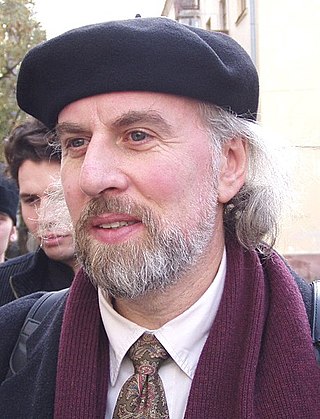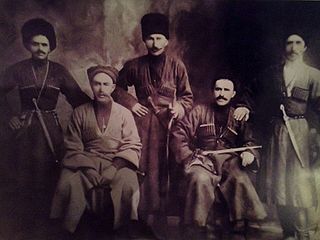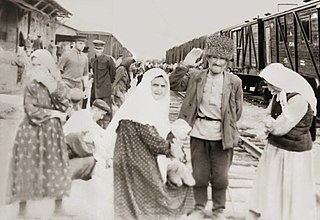
Nazran is the largest city in Ingushetia, Russia. It served as the republic's capital from 1991 to 2000, until it was replaced by Magas, which was built for this purpose. It is the most populous city in the republic: 122,350 (2021 Census); 93,335 (2010 Russian census); 125,066 (2002 Census); 18,246 (1989 Soviet census).
Tukkhum is a term and system introduced in the 1960s, most notably by Soviet Chechen writer Magomet Mamakaev in 1962. This system does not properly apply to the Chechen nation and the social structure of Chechen clans.
Semyon Isaakovich Volfkovich was an outstanding Soviet chemist, inorganic chemist, technologist, Doctor of Chemical Sciences (1934), member of the Academy of Sciences of the Soviet Union. He was engaged in the technology of production of mineral fertilizers, studied the processes of electrothermal sublimation of phosphorus. He developed an industrial scheme for producing potassium salts from sylvinite and a new technology for producing concentrated phosphate fertilizers. He was the first in the USSR to conduct research on fluoride gases uilization, to study the processes of processing mirabilite into soda and ammonium sulfate. He studied the catalytic and other properties of aluminum-, boron-, iron-phosphates.

Alexander Leonidovich Dvorkin is a Russian anti-cult activist. From 1999 to 2012 he was professor and head of the department of the study of new religious movements (cults) at Saint Tikhon's Orthodox University. He is currently professor of department of missiology at that university.

Sergey Semyonovich Nametkin was a Soviet and Russian organic chemist, a prominent researcher in terpene chemistry, the cracking of petrochemicals, and rearrangement of camphenes. Academician of the USSR Academy of Sciences. Winner of two Stalin Prizes.

Grunauer Alexander Adolfovich was a Soviet scientist and expert in the field of problems of regulation of internal combustion engines. An experienced teacher, professor. A Dr.Sci.Tech. (1969). Professor (1972). Chairman of department "Theory of mechanisms and machine" at the Kharkov polytechnical institute (1968—1993). The professor of the same department (1993—1994).

The Orstkhoy, historically commonly known under their exonyms: Karabulaks, Balsu, Baloy, are a historical ethnoterritorial society among the Chechen and Ingush peoples. Their homeland is in the upper reaches of the Assa and Fortanga rivers in the historical region of Orstkhoy-Mokhk. In the tradition of the Chechen ethno-hierarchy, it is considered one of the nine historical Chechen tukkhums, in the Ingush tradition as one of the seven historical Ingush shahars.
The Mamilovs are an Ingush tribal organization/clan (teip). The clan comprises about 1,500 people. It is one of a few Ingush clans whose members share one name.
Terki fortress, Terka, or Terek was a Russian fortress in the Caucasus in the 16-18th centuries. It was originally erected at the mouth of the Sunzha river on the lands of the Tyumen Khanate, it was demolished several times, restored and transferred.

Simsim was either a historical region or kingdom in the North Caucasus during the Middle Ages, existing in the 14th century. Predominantly localized roughly in Eastern Chechnya (Ichkeria), with some also connecting part of Kumyk Plain. Simsim is also localized in both Chechnya and Ingushetia. Its name may have been derived from the Chechen village of Simsir. However, according to folklore, the King Gayur-khan was chosen as the leader of all Chechens by the Mehk-Khel. In its later years it allied itself with the Golden Horde before being destroyed in 1395 by Timurlane, which was recorded in Zafarnama by Nizam al-Din Shami and the Zafarnama by Sharaf ad-Din Ali Yazdi.

Benoyn Boyshar, also known as Baysangur of Beno or simply Baysangur was a 19th-century North Caucasian commander of Chechen origin. He was one of the naibs (deputies) of Imam Shamil. Baysangur participated in the Caucasian War of 1817–1864.
Isa of Ghendargen was an Chechen General during the Caucasian War, who commanded the Eastern and Central Fronts of Caucasian Imamate. He is also one of the great commanders in Chechen history. Isa was of the Ghendargnoy teip and Appaz-Nek'e.

Ghendargnoy is a Chechen teip (clan). Its center is the village of Ghendargana. There is a hypothesis that it originated from the historic area in Chechen Republic called Nashkha.
Bamut is a non-residential rural locality in Sernovodsky District of the Republic of Chechnya, Russia. From 1922 to 1934, Bamut was a part of the Ingush Autonomous Oblast.

The history of metallurgy in the Urals stands out to historians and economists as a separate stage in the history of Russian industry and covers the period from the 4th millennium BC to the present day. The emergence of the mining district is connected with the history of Ural metallurgy. The geography of the Ural metallurgy covers the territories of modern Perm Krai, Sverdlovsk Oblast, Udmurtia, Bashkortostan, Chelyabinsk Oblast and Orenburg Oblast.

Restoration of the Chechen-Ingush autonomy by decrees of the Presidiums of the Supreme Soviets of the USSR and the RSFSR on January 9, 1957, the Chechen-Ingush ASSR was restored, and within slightly different boundaries than when abolished; Naursky and Shelkovskaya districts with a predominantly Russian population transferred in 1944 from the Stavropol Territory to the Grozny Region remained in its composition, but the Prigorodny District, which remained in North Ossetia, was not returned to it. The area of the republic after the restoration was 19,300 km². At the same time, the Chechen-Ingush population was forbidden to live in the southern mountainous regions of the republic adjacent to the Georgian SSRGo to the section «Socio-territorial changes».

Fappi or Fappi mokhk, exonym: Kistetia, is a historical region in Ingushetia. Fappi is the territory of historical settlement of the Fyappiy society.
The Dzherakh, also spelled Jerakh, historically also known as Erokhan people, were a historical Ingush ethnoterritorial society, today a tribal organization/clan (teip), that was formed in the Dzheyrakhin gorge, as well as in the area of the lower reaches of the Armkhi River and the upper reaches of the Terek River.
Muzhichi is a rural locality in Sunzhensky District of the Republic of Ingushetia, Russia, located on the left bank of the Sunzha River near the border with the Republic of North Ossetia–Alania. It forms the municipality of the rural settlement of Muzhichi as the only settlement in its composition.

The Aukh dialect is a dialect of the Chechen language. It is primarily spoken by residents in the northern part of Dagestan, and the estimated number of speakers is about 160 thousand.















